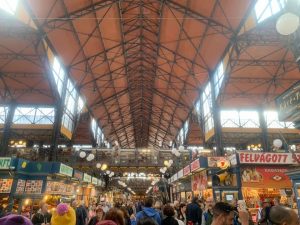14 October 2019
One huge difference between Europe and North America is that you can take a three-hour train ride to get to another country and never have your passport checked! Thursday morning, our group met at Hauptbahnhof and took a train to Budapest, Hungary. During our three full days in a new city, we had various tours, a theater performance, and free time. We stayed as a group at the Maverick hostel in the city center. The hostel used to be a Hapsburg mansion and had many royal aspects to the building. This was my first hostel experience, and it reminded me of a combination of a camp set up mixed with a hotel room.
For those that don’t know, Budapest is split into two sides by the Danube River. You have the “Buda” side, which is quieter and has less tourist attractions. The “Pest” side is lively and could keep you busy for days. We had a tour of each side, which included Castle Hill, the Parliament building, old bath houses, Hero’s Square, and Central Market Hall.
 There were a few differences between what we were used to in Vienna and what we had to quickly adjust to in Budapest. Hungarian currency is called Forints and has very little value. The average price of a meal was 3000 Forints. If I’m being honest, I had no idea how much I was paying for anything for most of our stay in the city. Another huge difference is language. In Vienna, we take German classes so we are becoming pretty familiar with the language. Hungarian is completely different. I had no idea how to even begin to sound out Hungarian words, so it was a relief that most people spoke English.
There were a few differences between what we were used to in Vienna and what we had to quickly adjust to in Budapest. Hungarian currency is called Forints and has very little value. The average price of a meal was 3000 Forints. If I’m being honest, I had no idea how much I was paying for anything for most of our stay in the city. Another huge difference is language. In Vienna, we take German classes so we are becoming pretty familiar with the language. Hungarian is completely different. I had no idea how to even begin to sound out Hungarian words, so it was a relief that most people spoke English.
On Saturday, we were given the day to explore. I’m more of a solo traveler so I went off on my own adventure on the “Pest” side of the city. I went back to Central Market Hall to get delicious Hungarian food, flavorful and savory. They are most known for goulash and Lángos. Goulash is a savory stew and Lángos is deep fried dough in which they dump toppings on top. Both dishes were unlike anything I’d eaten before, both tasty.
The main part of my day was spent at a museum called House of Terror, or Terror Háza in Hungarian. On their website, it includes this introduction: “Having survived two terror regimes, it was felt that the time had come for Hungary to erect a fitting memorial to the victims, and at the same time to present a picture of what life was like for Hungarians in those times.” In 1956, there was an uprising against the Cold War and the Soviet presence in Hungary. The Soviet Union responded with a military invasion, resulting in thousands of Hungarians fleeing their homeland. There was a Soviet presence in Hungary until 1991, when the last Soviet troops withdrew from the country. Hungary only joined NATO in May of 1999 and the European Union in 2004. Hungary has had a difficult history, one that has reached freedom much more recently than the United States.
One amazing part to this cross-cultural is all the comparisons we get to experience. We travel to so many cities in different countries and learn the history of that area. We witness theater, paintings, music, sculptures, memorials, and more that illustrate what life used to be in some places, what life is in others, and what life could be if we do not learn from the past. Just three days in one city has opened my eyes to how recent bad history is and the reality that things c an change in the world rather quickly.
-Mary Harnish
#EMUeuropetogether #EMUview

